- Bernard Preston homepage
- Arteries
- Kaempferol and Cancer Prevention
Kaempferol and cancer prevention
Kaempferol and cancer prevention is the subject of much scientific-research; it's just one of many bioflavonoids.
The reason for this paper is kaempferol's proven role in reducing oxidative stress in the body. That is the over-production of free radicals in the tissues; and the inability to neutralise and detoxify them.
Such is our lifestyle these days; over-production of free radicals. It comes as no surprise there there are so many heart attacks, strokes and cancer. Either your break out and make sure you are getting plenty of kaempferol and cancer prevention or you die long before your time.
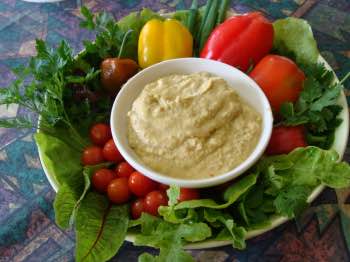
This page was updated on 5th July, 2025.
If you are heavily into your fruit and vegetables then you need have no concern; you're getting plenty of kaempferol. It is richly found in dark-green leafy vegetables, tomatoes and grapes, for example. And of interest to beekeepers in the propolis that is collected to seal up the hive and to protect the colony against invaders and even pathogens; it has anti-bacterial properties.
You also may be less concerned about the recent directive of the WHO that red meat is "probably" tumour-forming. More important, sadly is avoiding the processed salamis, sausages and bacon that are proven carcinogens; we love them. Keep them for high and holy days.
Kaempferol is a bioflavonoid found in the onion family, for example leeks; broccoli and kale too. In fact virtually all your greens from the garden are good sources. Pole beans, cucumbers and squash are also rich in the compound; apples and berries have this wonder phytonutrient as well. Those enjoying a wide variety of coloured foods need have little anxiety.
"Epidemiological studies have revealed that a diet rich in plant-derived foods has a protective effect on human health."
- Mini Rev Med Chem
Even potatoes give some protection to the meat and spuds man but remember much may be lost in peeling and in the liquids used to cook these vegetables; collect your water and add it when making stews, gravies and soups.
Making vegetable stock from scraps and cooking liquids will enrich all your dinner recipes.
However if you eat little fruit and greens then you should be concerned; you won't be getting enough of the flavonoids that help prevent metastatic-disease.
It all has to do with the wholeness of your food. It's one of the reasons we enjoy mulberry-jam on our bread despite the sugar; the fruit is rich in kaempferol.
On our artisan bread you need have no concerns about butter and jams; there won't be an insulin rush making you fat and potentially sick.
Kaempferol and cancer prevention
Kaempferol and cancer prevention benefits are found in leeks, broccoli and kale; and many other foods. It's a bioflavonoid that has a proven role in reducing oxidative stress in the body, by mopping up free-radicals.
Furthermore scientists are now looking at using kaempferol in the treatment of metastatic disease; for myself I advocate that we enjoy it daily in our food before we are struck down. An ounce of prevention is worth a pound of cure, even in a metric world.
It is absorbed in the small intestine and can be found in tiny concentrations throughout the tissues and the blood-plasma, of those who enjoy their greens and fruits daily; giving protection against the free radicals that are so destructive.
Overall vegetarian food plans give 23% protection against gastrointestinal tumours; this is even more true of the stomach where the relative risk is 0.41[3].
Breast and prostate tumours are a scourge in our society; kaempferol has been shown to mediate the estrogen receptors in these organs clearly reducing the noxious influence of the many carcinogens that we all face daily.
The reason it is so effective in all tumours is its ability to enhance the normal programmed cell death of these metastasizing tissues. In short it promotes this so-called apoptosis in a wide range of malignancies; one study even shows that it reduces the risk of pancreatic CA in smokers.
Kaempferol and diabetes
In one large study kaempferol from our food was shown to reduce the risk of adult-onset diabetes; and particularly the nasty complications of DM.
In the blood vessels it has been shown to reduce the oxidation of the LDL cholesterol that it is thought causes plaque; by promoting the scavenging of a host of highly reactive free-radicals. Current opinion is rather that it is the raised blood glucose associated with insulin resistance that initiates this inflammation associated with atherosclerosis.
There's a lower
risk of heart disease in any event in those enjoying their greens and berries, whatever the underlying physiology.
And so the list of kaempferol benefits goes on.
I hope you've enjoyed this journey into kaempferol and cancer prevention as much as I have. What grabbed my attention was many articles showing that leeks have powerful properties that help to reduce malignancies.
From there my search revealed that kaempferol is found not only in the allicin family but in a host of fruits and vegetables. Those who enjoy red-meat may be less concerned about its malignant properties provided they are daily also consuming those foods which are rich in bioflavonoids.
As you can guess we too love grass-fed red meat but are finding it increasingly difficult to locate, and it's expensive; so one way or another we are taking to the flexitarian way of eating.
It is one of the ketogenic diets; very low refined carbs and less red-meat. True wholegrains do not frighten us; rather, we embrace them. There is so much controversy even amongst the experts; we all have to work these things out for ourselves. Keep thinking and reading the research is our motto.
Understanding net carbs is the way to get your mind around whole-grains and legumes in a low starch wellness plan.
Grow your own cancer prevention
Food is defined as that which provides energy and nutrients. You can grow your own cancer protection because today's ultra-processed fare from the grocery store does not pass muster.
The best parts, the nutrients have been extracted and sent for animal feed; we are left with that which provides calories but is lacking in the substances needed to digest and utilise it properly. And that makes us obese. But your own garden will provide all the kaempferol you need so that one day you can "die healthy."
One in six people die an awful cancer-related death. "Not I," said the little red hen.
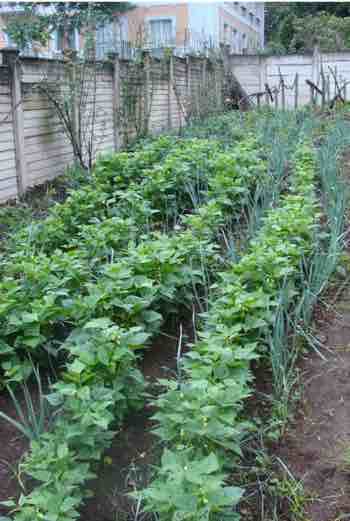 Rich in kaempferol
Rich in kaempferolBoth the green-beans and leeks in any garden are rich in kaempferol and cancer prevention.
So is it with the purple power in these berries which we enjoy for a short-month, and turn them into a delicious jam to be eaten for the rest of the year. Incidentally the good wife has found that when making jellies from fruit which is high in pectin she can reduce the recommended sugar by at least 40%.
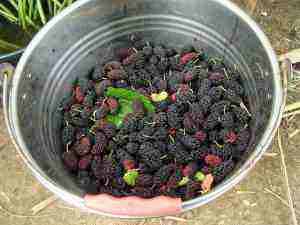
Mulberries also make incredibly good mead, by the way but that's only really for the beekeepers. The large amount of natural honey makes it very expensive otherwise.
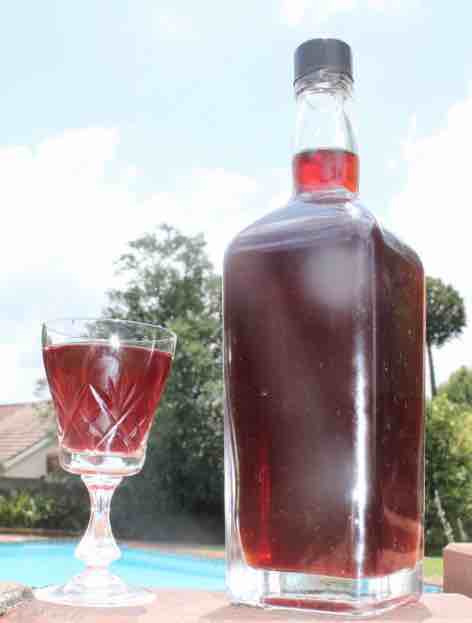
Pectin feeds the microbiome
Pectin is a polysaccharide made up of a string of glucose molecules; it is the soluble fibre in many carbs that binds dietary cholesterol, reducing absorption from the gut. Yang et al publishing in the journal Anaerobe, found that it also was the most potent starch for stimulating the microbiota in the colon; that is cancer prevention.
I also attribute to kefir benefits for permanently fixing my long-standing stomach pain in only one week.
Pectin
is particularly resistant to digestion in the small intestine where
many starches, and in particular those that are refined, would normally
produce a blood-glucose rush.
Don't just take my word for it; read this review on the dietary flavonoid kaempferol in the journal Medicinal Chemistry(1).
Kaempferol and bone protection
Kaempferol has many other important benefits, one of which is protection of the cells called osteoblasts that manufacture bone. They are damaged by free radicals and what are known as reactive oxygen species. Researchers have found that those enjoying foods rich in this very important flavonoid on a regular basis are far less prone to injury[2].
Growing leeks
Growing leeks for their kaempferol and cancer prevention properties is really only for the larger garden. Still I love the taste of a fresh green onion every morning in my Eggs Florentine; with the spinach I probably already have enough of this vital bioflavonoid for the day. Toss in a few slips of cilantro or parsley for a feast.
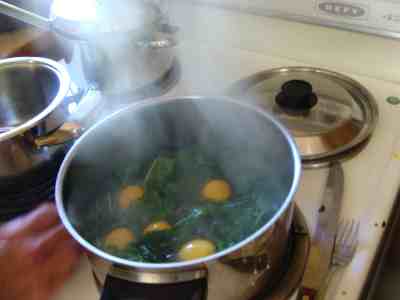
Allicin benefits
Allicin is another of those phytochemicals that has enormous nutritional benefits as an antioxidant.
Found largely in the allium family these benefits are to be enjoyed by those who love garlic, leeks and all the onions.
Allicin benefits, kaempferol and cancer prevention are subjects we could wax long into the night about. Meantime just enjoy your organic green food.
Kaempferol and Broccoli
Broccoli is another of those greens that is particularly rich in kaempferol and tumour prevention. It's known as the queen of the anti-carcinogens; it is also the best source of another phytochemical called glucoraphanin, the precursor of sulforaphane.
Obesity and diabetes are very much connected with cancer.
- Sulforaphane is also very important for diabetics
- Tobacco, obesity and alcohol are three preventable causes of cancer
Read more about sulforaphane at this broccoli facts page.
It is also particularly richly found in arugula, also known as rocket.
- Apple salad recipe for its kaempferol.
Mediterranean diet and kaempferol
Two of the five Blue Zones where 10 times as many people live to vigorous old age are found in the Mediterranean. Their diet consists of the following features; greens rich in kaempferol is one of them.
High
- Whole grains
- Legumes and particularly broad beans
- High fibre vegetables, especially greens
Low
- Saturated and trans fat
- Processed meat
- Sugar
Women with a high risk of recurrence of breast cancer were advised to go on the Mediterranean diet. Those who made the greatest improvement in their food choices demonstrated a 41% lower risk of a setback compared to those who settled for the fewest changes[4]; that's massive.
Unrefined flour presents the greatest difficulty, particularly since the Big Fat Lie; millers are now allowed by international law to extract up to 40% of the best parts, the germ and bran, and still label their products as "whole grain."
It is the lignans in the bran that give protection against breast cancer.
This French onion and blue cheese wholegrain quiche ticks most of the right boxes; there is some saturated fat in the dairy.
Kaempferol in propolis
Propolis is a resinous substance collected by bees to seal up large holes in the hive, protecting the colony against the weather and invaders. It is a rich source of the flavonoid kaempferol.
In my early days of beekeeping I recall us stressing the importance of "pure" honey. That was long before the days when men became skilled in doing wicked things like adulterating foods; we back then erroneously were attempting to cleanse out every speck of pollen and substances like propolis.
Now we realise that true natural honey is not warmed in any way but also only filtered very lightly to remove bee parts and other foreign debris. It is then allowed to settle for a few days; bubbles of air and other junk float to the surface and can be easily manually removed.
The prime honey that remains is a rich source of propolis and pollen. Alas you are unlikely to find it in the grocery store; rather consider a hive or two in the garden. Finding a small local beekeeper who is a naturalist is another option.
When browsing use right click and "Open Link in New Tab" or you may get a bad gateway signal.
Newsletter
Our newsletter is entitled "create a cyan zone" at your home, preserving both yourself and Mother Earth for future generations; and the family too, of course. We promise not to spam you with daily emails promoting various products. You may get an occasional nudge to buy one of my books.
Here are the back issues.
- Lifestyle and ideal body weight
- What are ultra-processed foods?
- Investing in long-term health
- Diseases from plastic exposure
- Intensive lifestyle management for obesity has limited value
- A world largely devoid of Parkinson's Disease
- The impact of friendly bacteria in the tum on the prevention of cancer
- There's a hole in the bucket
- Everyone is talking about weight loss drugs
- Pull the sweet tooth
- If you suffer from heartburn plant a susu
- Refined maize meal and stunting
- Should agriculture and industry get priority for water and electricity?
- Nature is calling
- Mill your own flour
- Bake your own sourdough bread
- Microplastics from our water
- Alternative types of water storage
- Wear your clothes out
- Comfort foods
- Create a bee-friendly environment
- Go to bed slightly hungry
- Keep bees
- Blue zone folk are religious
- Reduce plastic waste
- Family is important
- What can go in compost?
- Grow broad beans for longevity
- Harvest and store sunshine
- Blue zone exercise
- Harvest and store your rainwater
- Create a cyan zone at your home
Did you find this page interesting? How about forwarding it to a friendly book or food junkie? Better still, a social media tick would help.
- Bernard Preston homepage
- Arteries
- Kaempferol and Cancer Prevention
Address:
56 Groenekloof Rd,
Hilton, KZN
South Africa
Website:
https://www.bernard-preston.com